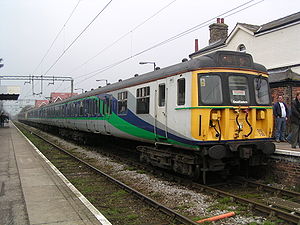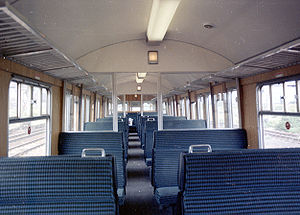British Rail Class 312
| British Rail Class 312 | |
|---|---|

Class 312, nos. 312718 and 312721, at Kirby Cross station in Essex on 6 March 2004. These units were operating a farewell excursion train ('The Grand Slam') to commemorate their retirement from service. These were two of the final three 312s in traffic, and were withdrawn in June 2004.
|
|

Inside a Class 312 driving trailer open before refurbishment. For second class passengers these trains had 3+2 high-back seating. Passengers were able to enjoy the driver's view through the windows between the cab and the passenger compartment, as seen here.
|
|
| In service | 1975 - 2004 |
| Manufacturer | BREL |
| Order no. |
|
| Built at | BREL York |
| Family name | BR First Generation (Mark 2) |
| Constructed | 1975-1978 |
| Number built | 49 trainsets |
| Number preserved | 2 cars |
| Formation | 4 cars per trainset: BDTSOL+MBSO+TSO+DTCOL |
| Diagram |
|
| Design code | AM12 |
| Fleet numbers |
|
| Operator(s) | British Rail |
| Depot(s) | |
| Specifications | |
| Car body construction | Steel |
| Train length | 256 ft 8 1⁄2 in (78.245 m) |
| Car length |
|
| Width | 9 ft 3 in (2.82 m) (overall) |
| Height | 13 ft 0 9⁄16 in (3.977 m) (pantograph down) |
| Floor height | 3 ft 9 in (1.14 m) |
| Doors | Slam |
| Wheelbase |
|
| Maximum speed | 90 mph (140 km/h) |
| Weight | Total - 156.6 tonnes (154.1 long tons; 172.6 short tons) |
| Traction motors | 4 × EE546A 201.5 kW (270.2 hp) |
| Power output | 1,080 hp (810 kW) |
| Train heating | Electric |
| Electric system(s) |
|
| Current collection method | Pantograph |
| UIC classification | 2'2'+Bo'Bo'+2'2'+2'2' |
| Bogies |
|
| Braking system(s) | Air (EP/Auto) |
| Safety system(s) | AWS |
| Coupling system | Buckeye |
| Multiple working | Within Class and Class 310 |
| Track gauge | 1,435 mm (4 ft 8 1⁄2 in) standard gauge |
The British Rail Class 312 is a type of alternating current (AC) electric multiple unit (EMU) built in 1975-1978 for use on outer-suburban passenger services. It was the last class of multiple unit to be constructed with the British Rail Mark 2 bodyshell, as well as the last with slam doors in Britain. These features contributed to their relatively early withdrawal at 25–28 years old, compared with a typical EMU life expectancy of 30–40 years.
These units were based on the Class 310 used on the suburban services out of London Euston, but were rated for a top speed of 90 mph (140 km/h), and they had flat windscreens from the outset. The only significant difference between sub-classes was that the 312/1 units were also equipped to work on the 6.25 kV AC overhead electrification system used on parts of the Great Eastern Main Line and London, Tilbury and Southend Railway networks.
As built, the 312/0 fleet were used on the newly electrified Great Northern outer suburban services from London King's Cross to Royston. The 312/1s were built for Great Eastern line services from London Liverpool Street. The four 312/2 units were mainly used to enhance local services between Birmingham New Street and Birmingham International, but were also used on other services in the West Midlands.
During the late 1980s, the class received an interior refurbishment that saw the wooden panel interiors covered with fascia panels, the removal of window blinds and other alterations. At the same time units lost their blue/grey livery (312/0) or all-over blue livery (312/1 and 312/2 as introduced) in favour of Network SouthEast (NSE) livery (312/0-1), whilst of the four 312/2 units, 312204 carried West Midlands Passenger Transport Executive yellow and blue livery and the others were dressed in the standard blue and grey, before their transfer to NSE.
...
Wikipedia
